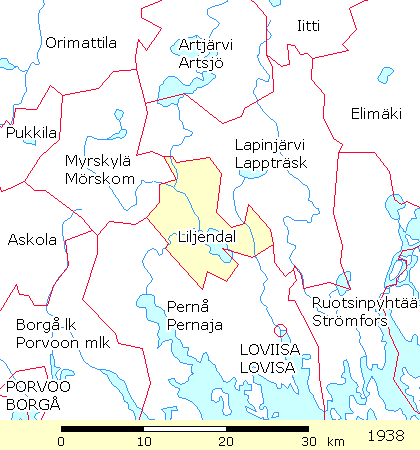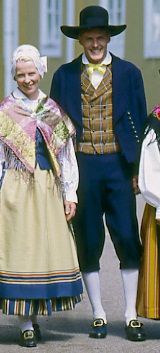Nyland
Liljendal
Villages & Farms
- Grims and Böhls
- Mattas
- Othas
- Flinkas
- Simos
- Hukus
- Backas
- Markufas
- Ersas
- Jossas
- Storkas
- Skomars
- Lillikas
- Jongas
- Skräddare eller Mattas
- Staffas eller Nybondas
- Olsas
- Backas and Tattars
- Mickos
- Backas and Tattars
- Ollas
- Knuts eller Nybondas
- Eskills eller Hårdvalls
- Lassas
- Haddas
- Tyskas
- Baijars
- Ollpetas
- Ollas
- Kuggantas
- Nissas
- Mattas
- Kuggas
- Labbas
- Lassas
- Eraas
- Nybondas
- Mattas
- Marieberg
- Gartz
- Klåskars
- Gartz
- Backas
- Gunnars
- Nybondas
- Heikas
- Hommas
- Lillveckum and Nyssugus
- Heikantas
- Jossas
- Storveckum
- Klåskas
- Petas
- Labbas
- Krogars
- Mickos
- Spåras
- Juvas
- Justas
Farm names not listed in parish records of 1880-1889
Resources:
- Liljendal, https://en.wikipedia.org/wiki/Liljendal
- Liljendal Church, https://sv.wikipedia.org/wiki/Liljendals_f%C3%B6rsamling
- Liljendal Church, https://www.agricolaforsamling.fi/kyrkor-och-lokaler/kyrkor/liljendal-kyrka
- Liljendal Church image, https://commons.wikimedia.org/wiki/File:Liljendalin_kirkko_2013.JPG
- Liljendal Folk Dress image, Brage costume agency, https://www.brage.fi/sve/draktbyra/draktbyran/folkdrakter/view-163648-108
- Liljendal Parish, Genealogical Society of Finland, HisKi project, http://hiski.genealogia.fi/hiski/aba128?en+0297
- Liljendal Parish Communion Records – 1819-1829: https://www.sukuhistoria.fi/sshy/index_eng.htm https://www.sukuhistoria.fi/sshy/sivut/HisKi-digiarkisto.php?bid=3512
- Liljendal Parish Communion Records – 1881 – 1890 parish records: https://www.sukuhistoria.fi/sshy/sivut/HisKi-digiarkisto.php?bid=23377




